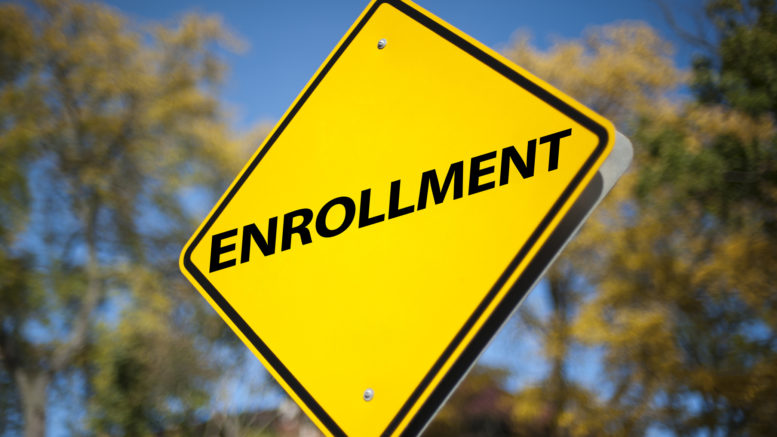Undergraduate enrollments grew this spring across all institution sectors, with community colleges accounting for more than half of the uptick, according to a new report. But officials are concerned whether the botched rollout of the new FAFSA form and process may stymie the momentum for coming fall enrollments.
Total undergraduate enrollment this spring grew 2.5% (359,000 students) over last spring, led by a 4.7% increase (200,000 students) at community colleges, which accounted for 55.7% of the overall growth, says the National Student Clearinghouse (NSC) Research Center in its analysis of spring data. Enrollment at primarily associate degree-granting baccalaureate institutions (PABs) turned the corner this spring and saw a strong increase (5.6%), following several years of decline in the spring term.
Doug Shapiro, executive director of the NSC Research Center, noted in a Zoom call with reporters on Tuesday that the rates of growth also “have ticked up a notch,” especially among community colleges, which was the sector hardest hit by the Covid pandemic, and among new students.
“The results are surprisingly good,” he said, speculating that students appear to still want college credentials despite concerns about higher education costs.
Related article: An early look at spring enrollments
Associate-degree enrollment continued its growth from fall 2023, with 179,000 more students (a 4.4% increase) than in spring 2023. Enrollment among undergraduate certificate programs also experienced continued growth, and enrollment in bachelor’s programs finally saw a bump after four straight spring terms of decreases.
Despite the optimistic figures, which have community college leaders hoping the increase will continue this fall, Shapiro emphasized — as he has during the center’s previous reports showing signs of enrollment resurgence — that there’s a long way to go to claw out of the enrollment trench resulting from the Covid pandemic. Compared to spring 2020, overall undergraduate enrollment is down -6.0% and down -12.4% among community colleges, according to the center.
Shapiro noted some concern whether the federal government’s problems with the FAFSA (Free Application for Federal Student Aid) will dampen enrollments, especially among students who were already on the fence about attending college this fall. While students with concrete plans to attend this fall will likely “get through the FAFSA,” those less certain “may have already made other plans,” he said.
Breaking down the data
The new report shows that dual-enrollment again had a significant effect on undergraduate enrollments this spring. The number of dual-enrolled high school students saw growth (10% or 101,000 students) for the third year in a row, accounting for 28.1% of undergraduate enrollment increases, according to the report. At community colleges, dual enrollment grew this spring by 10.2%, or 69,126 student.
Enrollment growth of older students was mixed among institution sectors. Community colleges and PABs saw an increase (3.8% at community colleges; 4.8% at PABs) for the first time since 2020, the center says. Public four-year institutions continued to see declines in students ages 21 to 24.
“Older learners had some of the biggest declines during the pandemic, so the fact that we’re seeing some of them stabilize is great news,” Shapiro said. “Of course, their numbers are much smaller to begin with, so that has less of an impact on institutions.”
Overall first-time freshmen enrollment also saw a bump this spring at 3.9%, with growth at community colleges (6.2%, or 14,000 students) and public PABs (11%, or 5,000 students) accounting for two-thirds of spring starters, the center says.
Surging career tech interest
The data indicate a continued strong interest in career and technical education (CTE) programs. The report says community colleges with a high CTE focus saw a 17.6% boost (117,000 students) this spring over last spring, and actually surpassed pre-pandemic figures by 6.1% (45,000 more students compared to spring 2020).
Enrollment at transfer-focused community colleges grew more slowly, the report says, with those colleges seeing a 3.6% increase among transfer-focused institutions and a 1.2% increase among mixed transfer-focused institutions.
There was widespread enrollment growth across major fields at community colleges and PABs, with the strongest growth among CTE-focused programs: mechanic and repair technologies/technicians (a 14.2% increase over last spring); multi/interdisciplinary studies (11.6%); precision production (10.2%); and construction trades (8.1%).
General liberal arts and science remains the program cluster with the largest enrollment at public two-year colleges, with nearly 1.4 million students this spring (a 0.8% increase). Health professions and related clinical science was second with 658,685 students, seeing a 4.4% growth. Third was business, management, marketing and related support with 449,785 enrollments this spring, a 3.0% increase from spring 2023.
PABs also had strong growth in many of the same fields, with the main outlier being social sciences, which saw a 16.6% increase, followed by construction trades (14.5%) and mechanic and repair technologies/technicians (12.4%).

